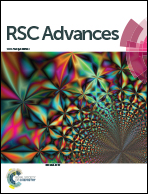CuO nanostructures: facile synthesis and applications for enhanced photodegradation of organic compounds and reduction of p-nitrophenol from aqueous phase†
Abstract
1D CuO nanorods and 2D CuO nanosheets were synthesized for the first time using amino acids, namely L-lysine and L-glycine, by a microwave assisted green synthetic route. The amino acids act as a good complexing and capping agent in the synthesis of CuO nanoparticles. L-Lysine mediated synthesis leads to the formation of CuO nanorods having an average diameter of 30 nm, while L-glycine assisted synthesis leads to the formation of CuO nanosheets with dimensions of 300–600 nm length, 200 nm width and 30–60 nm thickness. Hence, the morphology and size of the CuO nanoparticles can be varied by changing the amino acids, with other parameters remaining unaffected. CuO nanorods and CuO nanosheets were characterized by FTIR, XRD, TEM, SAED and UV-visible spectroscopy. XRD, FTIR and SAED reveal the monoclinic phase of CuO nanoparticles. Absorption spectra of CuO nanorods and nanosheets show a broad absorption band around 380 nm and 383 nm, respectively, due to surface plasmon absorbance of CuO. A clear blue shift in the band gap energy of synthesized CuO nanorods was observed from CuO nanosheets, with a decrease in particle dimension due to the quantum effect. The catalytic activity of synthesized CuO nanorods and CuO nanosheets was studied for the reduction of p-nitrophenol to p-aminophenol. The results showed an enhanced catalytic potential of 1D CuO nanorods as compared with that of 2D CuO nanosheets. The photocatalytic activity of synthesized CuO nanoparticles was also evaluated for the degradation of two different toxic dyes, namely methylene blue and eosin Y, under solar irradiation. The degradation products were analyzed and a mechanistic pathway for the degradation is proposed.


 Please wait while we load your content...
Please wait while we load your content...